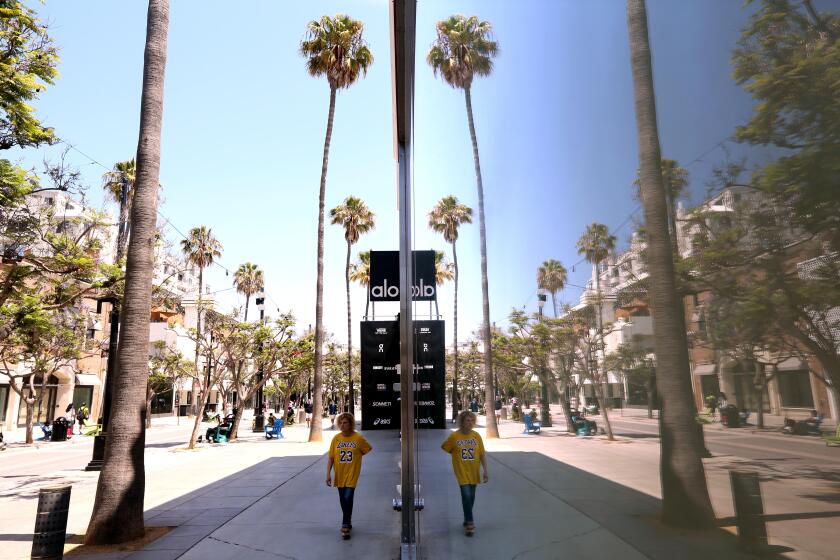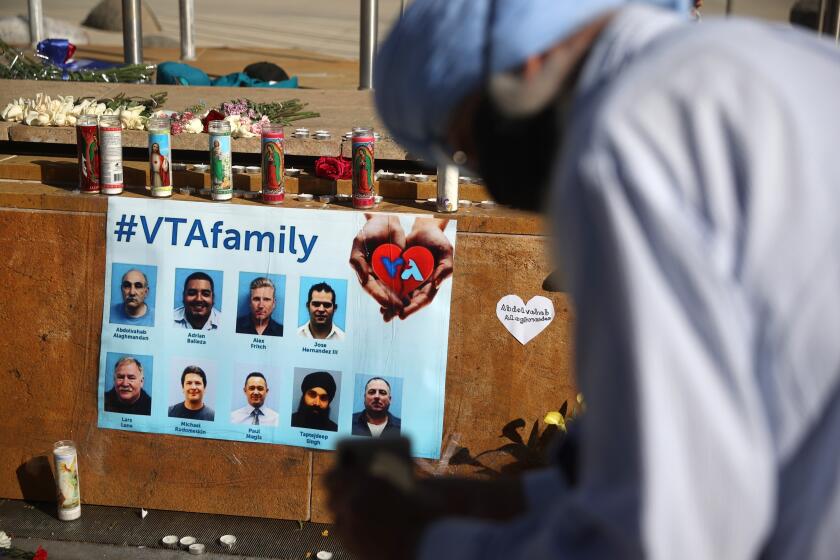U.S. aims to ease a wary flying public
As the busy Thanksgiving travel days approach, government officials went on the offensive Monday to quell passenger complaints about full-body scans and aggressive pat-downs at airports, saying the hype swirling around a few highly publicized cases does not reflect the reality of the new safety inspections.
In the first two weeks after the enhanced screening measures began Nov. 1, the Department of Homeland Security said about 700 of an estimated 28 million airline passengers lodged complaints with the Transportation Security Administration.
The TSA released a public service announcement Monday with advice for travelers, emphasizing that the pat-downs are rare -- involving 3% of all airline passengers -- and that travelers can request that they be done in a private room.
Of the passengers asked to submit to a full-body scan, 1% have chosen to instead undergo a pat-down, which includes TSA agents using their hands to check sensitive areas such as the groin and bra area.
Mayor Antonio Villaraigosa sought to reassure the flying public Monday by stepping into a body scan machine at Los Angeles International Airport. As Villaraigosa raised his arms, a screener in another room peered through his dark suit and peach tie for contraband.
Within five seconds, his screening was done. He urged those thinking of opting out for reasons of privacy or modesty to reconsider.
“That’s the wrong way to go,” the mayor said as cameras rolled. “We all have to recognize that these are different times. ... And that’s why these layers of security are being installed.”
Despite the efforts, the government was still facing formidable opposition in the form of widely circulated Internet videos. In one video, TSA agents at the Salt Lake City airport were performing a pat-down on a young boy after his father decided to remove the boy’s shirt. In another widely-seen YouTube clip, San Diego native John Tyner warns agents not to “touch my junk” as he refuses to submit to either a full-body scan or a pat-down.
The protesters found some sympathetic listeners on Capitol Hill. Sen. Olympia J. Snowe (R-Maine) sent TSA chief John Pistole a letter requesting information about the training officers received before the pat-downs began.
Rep. Jason Chaffetz (R-Utah) called for an investigation into the Salt Lake City incident.
A loose network of groups opposed to the new rules are urging air travelers to opt out of full-body imaging machines Wednesday -- among the busiest travel days of the year -- in an effort to create delays in security lines. TSA officials said they would have extra workers on duty to deal with any slowdowns.
Yet passengers, despite worries about screeners seeing images of their naked bodies or harm from the machine’s radiation, are overwhelmingly choosing to go through the body scanners instead of opting for the pat-down, said Randy Parsons, TSA federal security director for LAX.
Since late October, just two LAX passengers have opted for the alternative pat-down screening -- out of an estimated 80,000 to 90,000 people who daily pass through security, Parsons said.
Meanwhile, an ABC News/Washington Post poll released Monday found that Americans supported use of full-body screening machines by a 2 to 1 ratio, but were evenly divided about pat-downs. Sixty-eight percent of respondents said it was more important to investigate possible terrorist threats than to protect personal privacy.
In Washington, Pistole said his agency was constantly working to “blend privacy and security,” responding to travelers’ concerns while still confronting threats such as last year’s Christmas Day would-be bomber. In that case, authorities said a Nigerian man was able to board a plane carrying PETN, a powdered explosive that he hid in his underwear as he passed through a metal detector. Pistole said the new guidelines were developed to address that vulnerability in airport screening.
Federal officials have emphasized that under the new policy, most passengers will continue to pass only through metal detectors. A smaller group will be asked to submit to a body scan. Only passengers who refuse the body scan or trip the alarm on the metal detector will be asked to undergo a pat-down.
TSA agents can allow passengers who trip the metal detector to check again for any metal and pass through the detector again.
With the body scanners, the TSA uses software and other technology that blurs the faces of passengers or doesn’t pick up facial features.
In terms of radiation exposure, the energy is thousands of times less than that of a cellphone transmission, federal officials said.
The scanners do not store the images.
Even as it stood by the new policies, White House Press Secretary Robert Gibbs said the Obama administration was constantly reevaluating security techniques, saying they “have to evolve.”
“Our goal must be to maximize protection and security and minimize inconvenience and invasiveness,” Gibbs said. “It’s not an easy task.”
The TSA intended to put the new rules in place over time, but Pistole accelerated the plan after the package-bomb plot in October, when terrorists put printer cartridges filled with PETN in packages sent from Yemen, intending for the bombs to explode on cargo planes as they flew over the U.S.
Pistole said he overruled a recommendation from his aides for a public relations effort to explain the enhanced screening.
“That was my decision,” said Pistole, who said he did not want to give too much information to would-be attackers.
“We know that [Al Qaeda members] have visited the TSA website,” Pistole said.
Also, he said, members of Al Qaeda have visited the body scanner manufacturer’s website to check the technical specifications.
--
catherine.saillant@latimes.com
Memoli reported from Washington and Saillant from Los Angeles. Brian Bennett of the Tribune Washington bureau contributed to this report.
More to Read
Inside the business of entertainment
The Wide Shot brings you news, analysis and insights on everything from streaming wars to production — and what it all means for the future.
You may occasionally receive promotional content from the Los Angeles Times.












